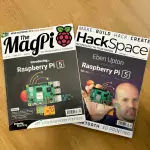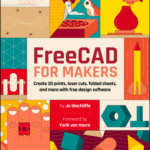There’s a brand new issue of HackSpace magazine out and this interview with the legendary Tim Hunkin is one of our very favourite things from its pages.
Think of automata, and the image that pops into your head will most likely depend on your age. If you’re a child of the 1980s, you’re most likely imagining the seaside amusement from the film Big that turns a child into Tom Hanks. If you’re a child of the 1880s, you might be thinking of the Mechanical Turk, the machine that terrified audiences by seeming to play chess against a human opponent.

Others still may think of the works of Tim Hunkin. He’s been building machines to inspire and delight for decades, and now has two arcades full of his own creations: Novelty Automation in London, and the Under The Pier Show in Southwold. We caught up with him to chat about precision, engineering, and the joy of the mechanical in a digital world.
Your essay on precision reminded me of something my father used to say whenever I was helping him with DIY jobs: “We’re not building pianos.”
Tim Hunkin: I like this one: “Jack of all trades, master of none – but oftentimes better than master of one.”

Is there still room for the Jack of all trades? It feels like graduate jobs have replaced apprenticeships as entry-level jobs so, by default, any new engineer, programmer, or whatever will have three or four years’ specialisation behind them already.
Good question. You’re right that big companies now only hire people who tick the boxes. But it’s much less proscribed for tiny businesses – which is now where most innovation comes from. Will Jackson, a friend who runs Engineered Arts, a successful robot company, generally only employs school leavers who pass his tests to show their aptitude. For something like robotics, it’s essential to be able to move seamlessly from hardware to software when solving problems. So, although it often feels like being an old hippy or being a Jack of all trades, I still feel it’s very valuable – if,
for nothing else, to reduce development costs.

You say in your essay on precision that, “Sadly most engineers have to be intensely conservative about their designs. It’s expensive to try anything new, and even more expensive to rectify something that doesn’t work. Also, because they rarely make their own parts, any detail that’s imperfect is alarming to them, even though the part might still work perfectly well.”
On this logic, I’d argue that most people who make things for their own consumption – makers, home tinkerers – would be inventors, rather than engineers. Do you agree? And do you see yourself as conservative in your own designs?
I hadn’t thought of it like that, but I guess it’s basically true. It’s partly because most engineers work on big projects where the huge scale needs mathematical calculations and any mistakes are hugely expensive. Generally, people think of engineers as boring – I don’t, but it can be useful. Trapped talking to someone tedious at a party, saying that I’m an engineer is a sure way to get them to move on.
I often try out new stuff but am also quite conservative. I think the reason why there aren’t any other ‘homemade’ arcades is that it’s so hard to make the machines reliable enough. Many of mine have now been used over 100,000 times. So, personally, I am both – inventor and engineer.

I was amazed to discover on a recent visit to the Science and Industry Museum in Manchester that Joseph Whitworth built a system that could measure to an accuracy of one-millionth of an inch in 1840. How does the average garage-based inventor/maker get anywhere near this level of accuracy?
I don’t – I rarely work to more than .02 mm (the resolution of my lathe and mill DROs). At university, in 1970, I was taught about tolerances and told not to specify more precision than necessary because it added cost. With today’s CNC tools, this is less important and designers often lack the practical experience to know what tolerance is needed for a part, so specify tight tolerances just to be safe.
“Builders use laser levels to make walls and floors accurately vertical and horizontal because it saves time – there’s less measuring to do. This is partly why it’s often cheaper to knock down an old house and build a new one, rather than to restore the old one.”
This is something I’d never thought about before. We’ve obviously gained a lot through increased accuracy, but do you think we’ve lost anything in the process?
Yes. Vernacular architecture has a charm no architect can match. Many more tourists flock to ‘picturesque’ villages than to ‘modern’ architecture – and none to housing estates, today’s closest equivalent to a village. In my 20s, I made some furniture and often tried to cut everything with a jig-saw (avoiding using a table or bandsaw) just so, when you run your finger along an edge, it feels uneven and handmade.

How did someone with no apprenticeship or degree end up being trusted to design gates to separate tigers from delicious, meat-based members of the public?
I’d made an elaborate clock for the zoo a few years before, and became friends with the architect. Designing the tiger enclosure, the architect found the only ‘off the peg’ vertical gates were German electrically-operated ones that cost a fortune. So, he asked me if I could come up with a simpler idea. So, really, the answer to your question is that once
someone has a body of work, no one asks to see their qualifications. I do actually have an engineering degree, but no one has asked to see it.
Is that something you’d offer as advice to home- and shed-based makers? And what’s the best way to build up that body of work, and make sure it attracts the right eyeballs?
It wouldn’t work for most people. But it can for anyone who’s driven to pursue stuff that interests them, rather than to make the most money. For them, my advice is simply don’t give up – it always takes longer than you think.

Many of our readers will know you already from The Secret Life of Machines [at this point we’d direct anyone who hasn’t done so already to go to YouTube and watch every single episode of Tim’s series, The Secret Life Of Machines, swiftly followed by The Secret Life of Components – for most people, they’re better than an engineering degree]. Would it be possible to make The Secret Life of Machines today, or are modern devices too boringly dependent on electronics?
I’m often asked, or encouraged, to do an update with today’s machines. The problems with today’s machines are that there’s less to point a camera at, and that hacking into the software would be an essential ingredient, but I don’t have the skills or interest to do it.
There’s something Hogarthian about a lot of your automata, in the way it pokes fun at the world around us. Do you see yourself as a mechanical satirist?
I’m quite happy to be described as that, and I am also a huge Hogarth fan. But there is another strand that’s important to me, which is the importance of working with your hands. There are far too many people who spend their lives preaching about their pet subjects, so I prefer just to demonstrate what’s possible.

If I’m reading your website right, you made your first automaton in 1980, for Cabaret Mechanical Theatre in Covent Garden. Did they approach you, or the other way round? What did that first automaton do, mechanically?
Actually, I started making automatons when I was a kid. I think I made ‘Gladys the burglar catcher’ when I was 14. As a teenager, I loved London’s many surplus shops and made bits of ‘kinetic art’ thinking they were more sophisticated than my earlier machines. But when I moved to the country, and got my workshop in my late 20s, I returned to making automata, all out of wood at first. I used to take them to the local fairs and steam rallies. But they took up a lot of space so, when I heard Cabaret was moving from Falmouth to London, I got in touch.
How do people react when they see Novelty Automation? Loads of people spend their time staring at screens, I’d imagine that even though the technology is old, many of your visitors won’t have seen anything like it before.
At first, most people were baffled by Novelty Automation and we lost money. Fortunately, after a year or two, Atlas Obscura got interested, which led to more videos and publicity. Now people know about the place, it’s a great advantage being different from anything else. It’s also fortunate that the short videos visitors take of each other using the machines are perfect for TikTok.
Do you have a favourite Secret Life, whether Machines or Components? If so, why?
I do have a favourite arcade machine at the moment, ‘Trust Wildlife?’ I spent over a year making it, and had no idea what it would be like until I added the sound track in the last month or two. I used my own voice, greatly improved with Adobe Audition, which was fun. But really, why I like it is that, a few months after putting it on the pier, I was showing a couple of visitors around and, while they were inside, I realised something that had never occurred to me before – the seagulls say pretty much exactly what I think of the world.
HackSpace magazine issue 68 out NOW!
Each month, HackSpace magazine brings you the best projects, tips, tricks and tutorials from the makersphere. You can get HackSpace from the Raspberry Pi Press online store or your local newsagents.










